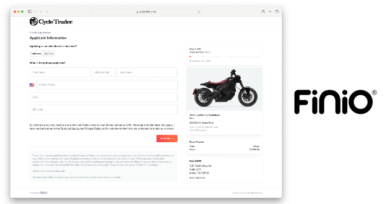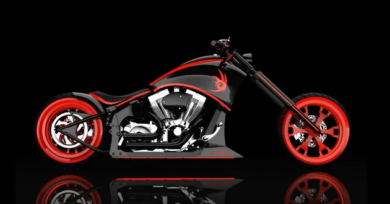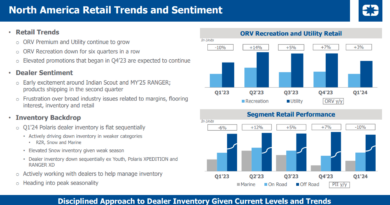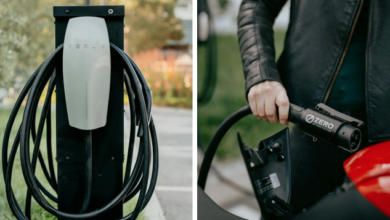Motorcycles in the movies
Ducati and Triumph lead the list of motorcycle manufacturers that have had impressive starring roles in feature films over the last six months. A Ducati 996 Superbike makes a showing in a dramatic chase scene in “The Matrix: Reloaded,” the highly anticipated sequel to “The Matrix” starring Keanu Reeves.
“Movies don’t get any bigger than this,” says David Gross, Ducati creative director. “The Matrix bike chase scene — without giving anything away — is going to be mind blowing.”
Earlier in 2003, a Triumph Bonneville bowed in “How To Lose A Guy in 10 Days,” starring Matthew McConaughey and Kate Hudson. “Hollywood has taken note of Triumph’s rebirth,” says Mike Vaughan, CEO of Triumph Motorcycles (America). “Triumph’s reception from American and world market consumers continues to grow and we are pleased that Hollywood is recognizing what motorcycle enthusiasts have come to know over the past decade with the reintroduction of Triumph.”
Triumph motorcycles also have been seen recently in “Daredevil,” “Mission Impossible II,” “Tuck Everlasting,” “and Torque.” Trumph also will be seen in the upcoming “T3: Rise of the Machines.”
“All this offers us great exposure to an audience that may have an affinity for motorcycles but doesn’t know Triumph exists,” said Vaughan.
Motorcycles have been making appearances in movies ever since Marlon Brando first threw a leg over the saddle of his Triumph Thunderbird in the 1950s flick “The Wild One.” More recently, there’s been not only feature films centered around the motorcycling culture, like “Biker Boyz” and “Torque,” but plenty of movies where a motorcycle is a key prop in the storyline.
“Motorcycles are a hot commodity and they have been for awhile,” says Christopher Wagner, president of Royal Promotions and Placement, a product placement firm in Los Angeles. “A motorcycle, like any prop in a movie, helps define what the characters are about.”
Wagner is Triumph’s exclusive Hollywood agent looking for favorable product placements for the British motorcycle company in movies and on television. He says a motorcycle evokes “cool,” so when a director calls for a character to ride one, they’re trying to shape that character’s personality. “The motorcycle defines that they’re hip, they’re cool, that they’ve really got it together,” Wagner says. And for whatever reason right now, motorcycles are being called upon as that cool-defining prop — a far cry from when a motorcycle defined the “bad boy.”
How It Works
Not all manufacturers have an agent working for them in Hollywood. Lee Edmunds, American Honda’s press relations manager, says Honda doesn’t need a product placement company because so many opportunities are presented without one. “The movie industry has been paying much more attention to motorcycles and in many cases they are the ones aggressively seeking product.”
Same for Yamaha, Suzuki and Harley-Davidson. None of these manufacturers retains a product placement company on a full-time basis. But representatives from all these companies agree that positive placement is a key factor when evaluating whether they’ll allow a motorcycle to appear in a particular project. “We love having product placement in movies as long as it promotes the industry and product in a positive light,” says Edmunds.
One of the most popular motorcycle brands to recently appear in Hollywood productions is Indian, which used a product placement firm to get its American-made cruisers in over 50 TV shows and movies during the past two years. An Indian Chief motorcycle, operated by Arnold Schwarzenegger, will appear in the film “T3: Rise of the Machines,” scheduled for release July 3. Indian provided eight motorcycles during the filming of T3, each of which was configured as a specially made police machine.
Schwarzenegger’s movie ward, John Conner, will ride a Triumph Bonneville in the film.
Because Triumph is a secondary player in the American motorcycle market, Vaughan feels retaining a product placement company is key in exposing the brand. “We view his (Christopher Wagner) efforts as a key link in our marketing chain.”
Wagner says the way a movie company obtains a motorcycle is very simple. “It’s exchange of a loaner bike for the exposure of the product. Cash does not change hands.”
He adds it’s also very important to have the full cooperation of the manufacturer supplying the bike. For example in “How To Lose A Guy in 10 Days,” Wagner says Matthew McConaughey called him and said he really liked the Bonneville, but his character is such a motorcycle enthusiast that he might customize the bike.
Wagner continues, “So, I talked to Mike (Vaughan) about it. Some manufacturers might fear all that customizing might not represent their product, but Mike was savvy enough to understand that motorcycle enthusiasts do that, they customize their bike, so he said, ‘Let’s do it.’”
Vaughan sent boxes full of Triumph parts and accessories to the movie set. “When you get that kind of cooperation from a manufacturer you get a lot of people who want to go your way.”
Dealer Participation
Obviously, the hope is that national and worldwide exposure of a motorcycle brand will drive consumers into dealer showrooms. But how can dealers capitalize on the momentum of a particular motorcycle starring in a movie?
“The successful dealers take the bull by the horns,” says Vaughan. “They go to their local theaters and chat with the manager and get a bike in the lobby, a sign on the bike and so on.”
On some occasions, a manufacturer will promote the movie partnership on a national level offering support to the local dealers.
Triumph conducted a sweepstakes through Lowes theater chain for “How To Lose A Guy,” and supplied its dealers with counter cards and displays.
For “The Matrix: Reloaded,” Ducati teamed with Warner Brothers, the distributor of the movie, to promote its world premiere. At the May 14 premiere in Los Angeles, a Ducati stunt team performed in front of Mann’s Chinese Theater to a crowd of thousands of moviegoers, celebrities, and print and TV journalists. There also was a drawing held on the radio whereby a member of the audience could win the same Ducati Superbike featured in the movie.
When is it not a good idea for a manufacturer to align itself with a particular movie? “It’s not unusual for a movie studio to want to use our bikes for a chase scene or to crash them in the end or change them in some way that you can’t identify them,” says Mark Reese, press representative for American Suzuki. “We don’t see any benefit in that.”
Suzuki did see a benefit in allowing a RM250 dirt bike to make an appearance in “Charlie’s Angels: Full Throttle,” opening this month.




